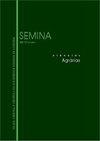两种放牧强度下Brachiaria草(Urochloa decumbens Stapf。)牧场与饲草花生间作的形态、结构和化学特征
IF 0.5
4区 农林科学
Q4 AGRICULTURE, MULTIDISCIPLINARY
引用次数: 0
摘要
本研究的目的是评估在三个行距(40、50和60cm)和两个放牧后剩余高度(5和15cm)下,Brachiaria草(Urochloa decumbens)与饲料花生(Arachis pintoi)间作的形态、结构和化学特征。实验采用随机区组设计,采用析因方案(3×2),四个重复。采用析因方案(3×。对通过切割和手工采摘取样的化学特性进行了评估。Brachiaria草在5cm处的粗蛋白含量最高,而饲草花生在15cm处的粗蛋白质含量最高,但在第二年没有差异。与单作相比,间作导致最终茎粗较低,活叶数量较多,并增加了以下指标:叶片伸长率、最终叶粗和叶片寿命,第二年的剩余高度为5厘米。饲草花生主要在放牧后5厘米的高度管理时改善了Brachiaria草的形态形成和结构特征,而不考虑行距。本文章由计算机程序翻译,如有差异,请以英文原文为准。
Morphogenic, structural, and chemical characteristics of Brachiaria grass (Urochloa decumbens Stapf.) pastures in monoculture and intercropped with forage peanut under two grazing intensities
The objective of this study was to evaluate the morphogenic, structural, and chemical characteristics of Brachiaria grass (Urochloa decumbens) intercropped with forage peanut (Arachis pintoi) under three-row spacings (40, 50, and 60 cm) and two post-grazing residual heights (5 and 15 cm). The experiment was performed in a randomized block design with a factorial scheme (3 x 2) with four replicates. The structural and morphogenic characteristics were considered in a factorial scheme (3 × 2) + 1 (an additional treatment of Brachiaria grass in monoculture). Chemical characteristics sampled by cutting and by hand plucking were evaluated. Brachiaria grass had the highest crude protein (CP) content at 5 cm, whereas forage peanut had the highest CP content at 15 cm in the first year, however, there was no difference in the second year. Compared to monoculture, intercropping resulted in lower final stem size, a greater number of live leaves, and increases in the following metrics: leaf elongation rate, final leaf size, and leaf life duration, most consistently with 5 cm residual height in the second year. The forage peanut improved the morphogenic and structural characteristics of Brachiaria grass primarily when managed at 5 cm post-grazing height, regardless of row spacing.
求助全文
通过发布文献求助,成功后即可免费获取论文全文。
去求助
来源期刊

Semina-ciencias Agrarias
农林科学-农业综合
CiteScore
1.10
自引率
0.00%
发文量
148
审稿时长
3-6 weeks
期刊介绍:
The Journal Semina Ciencias Agrarias (Semina: Cien. Agrar.) is a quarterly publication promoting Science and Technology and is associated with the State University of Londrina. It publishes original and review articles, as well as case reports and communications in the field of Agricultural Sciences, Animal Sciences, Food Sciences and Veterinary Medicine.
 求助内容:
求助内容: 应助结果提醒方式:
应助结果提醒方式:


